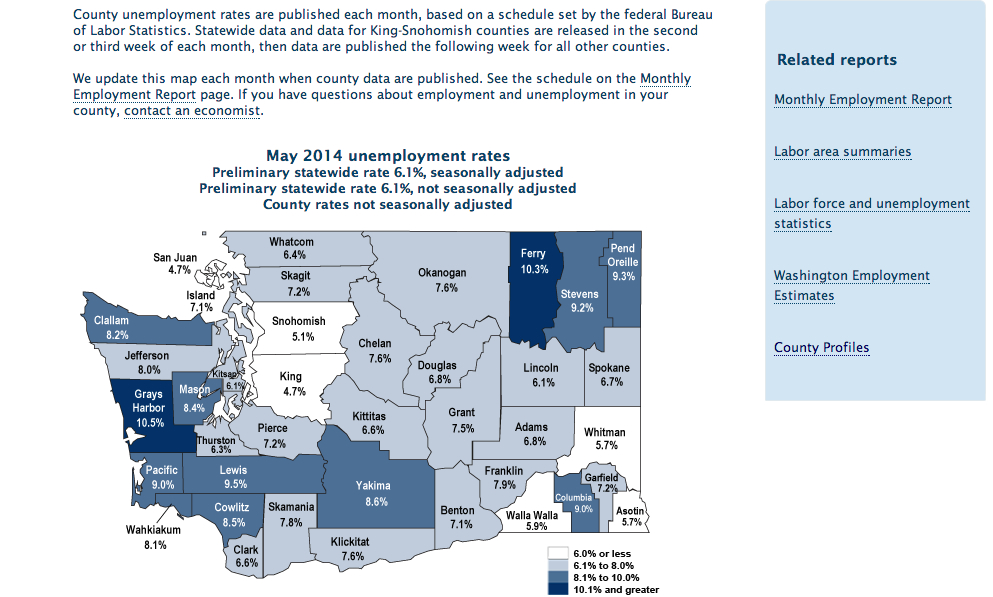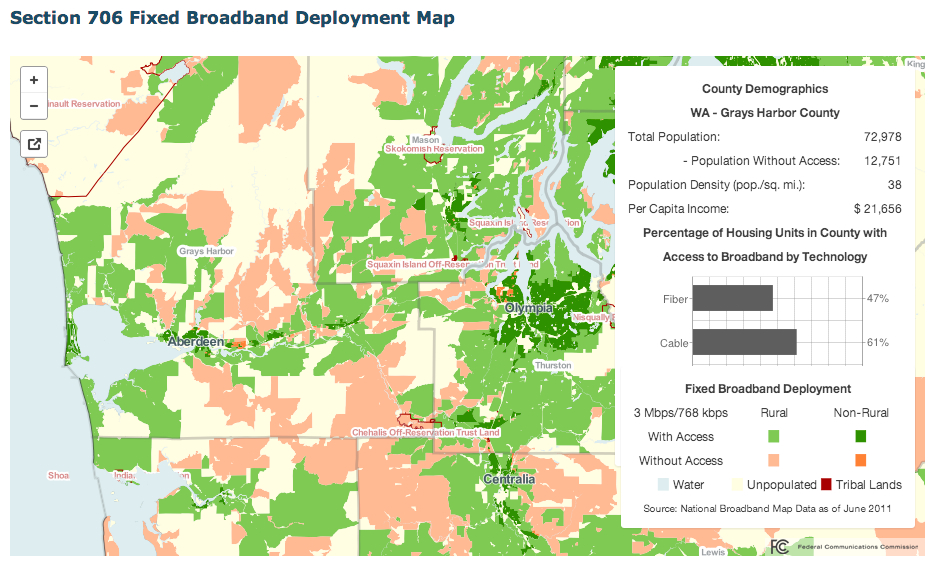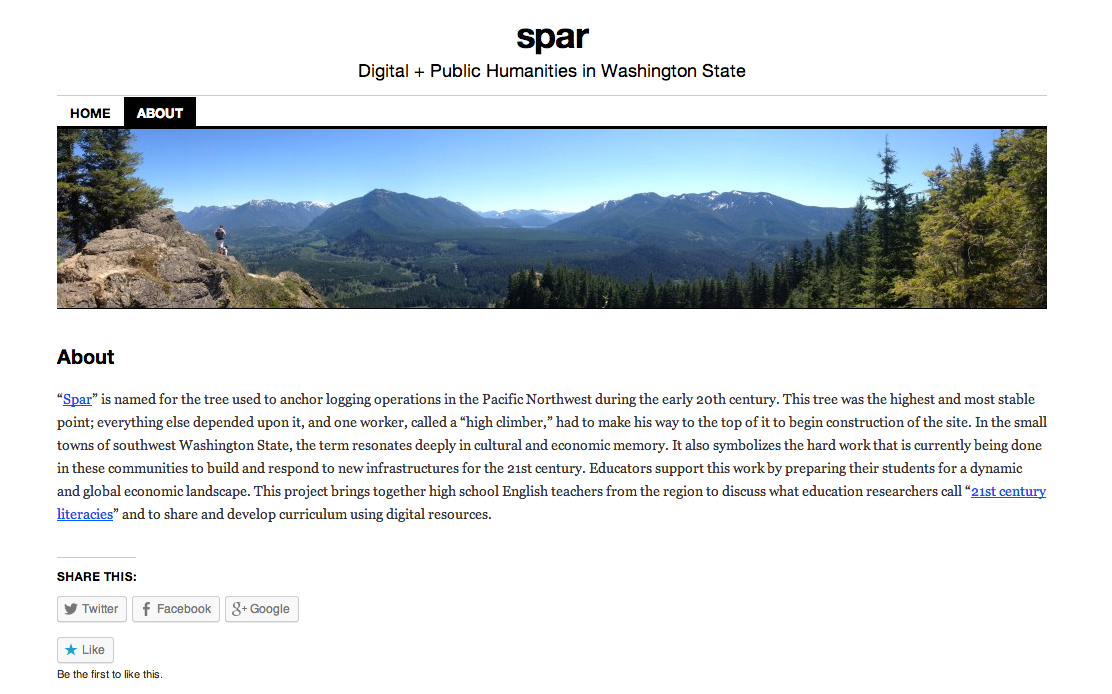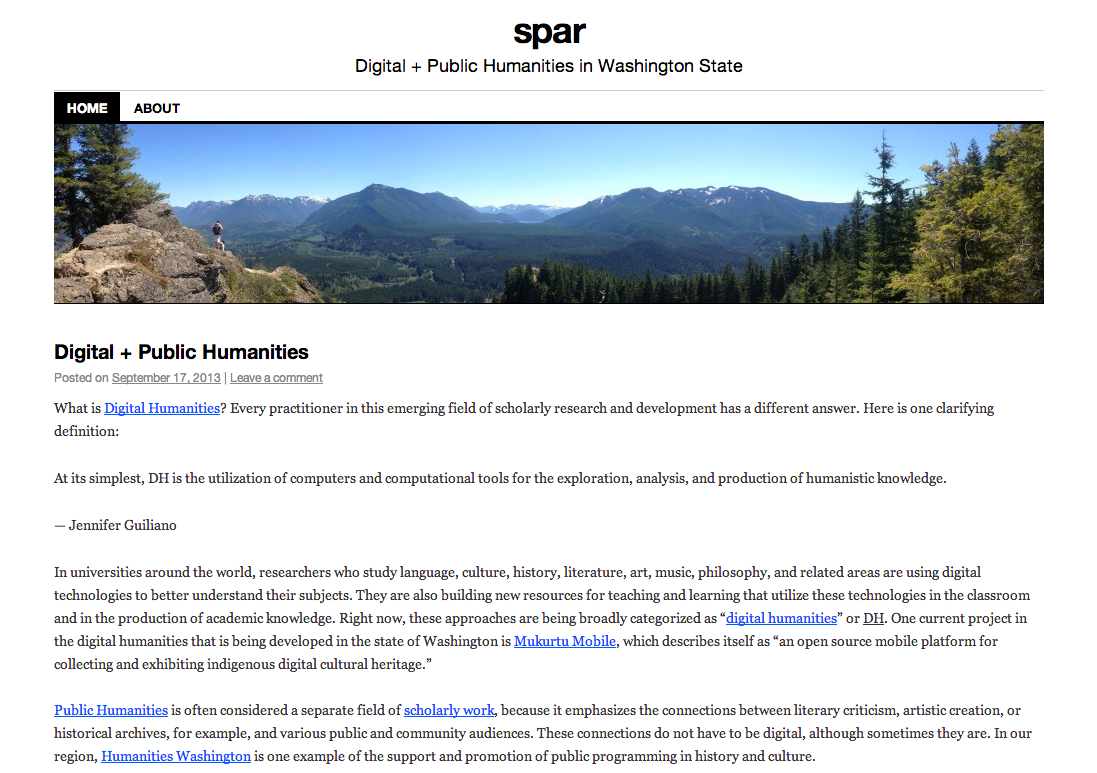Spar: Digital Humanities, Access, and Uptake in Rural Southwest Washington State
by Rachel Arteaga
published July 2014
In his account of the industrialization of the logging industry in the Pacific Northwest, historian Richard Rajala describes the use of the now obsolete high-lead logging method in the early 20th century. It required one worker, called a high rigger, to cautiously make his way to the top of the tallest tree in the vicinity to begin construction of the site. This tree was called a spar, and it was the highest and most stable point; everything else depended upon it (24). In the small towns of southwest Washington State, the term resonates deeply in cultural and economic memory; while logging still accounts for a significant share of labor activity in the region, the industry has receded amidst environmental regulation and shifting markets, leaving high unemployment numbers and limited professional alternatives in its wake. As the name of the project that this article announces, “Spar” communicates a sense of place and symbolizes the high stakes and potential challenges of building new infrastructure and partnerships for effective digital resource use in rural high school classrooms.
Spar is a hyper-local pilot project currently in development that will initiate and document discussions among English teachers from ten rural school districts in Grays Harbor County, Washington. Through participatory research, it seeks to describe the current use of technology in the classroom; account for the effects of limited broadband access in local households; and determine whether and how new resources in the field of digital humanities (DH) are currently being taken up, or could be implemented into future curricular models. By bringing the high school English curriculum into conversation with new resources in the academic humanities, the project aims to support the teaching of 21st century literacies in communities hard-hit by a series of economic downturns and to counter a historical disconnect between the university and rural students (Irvin). At stake for the field of digital humanities is a return to foundational statements regarding public access, a reconsideration of the user, and an expanded approach to resource evaluation. In its final report, Spar will document whether the analytics it investigates might allow for wider dissemination and application of existing digital resources beyond the research universities in which they were developed, and make recommendations for best practices in designing and adapting such resources for uptake in high school classrooms.
Spar is doing its work at the intersection of digital and public humanities. Part of its object of study is the significance of these terms outside of academia, in learning communities that are disconnected from university research centers both geographically and institutionally. Rural high schools exemplify this notion. How do we understand the terms digital and public humanities? One way to answer this question is to engage in participatory research to discover how educators across institutional contexts understand these terms differently. In doing so, this project seeks the institutional limits of the term “digital humanities”; specifically, when it is dislocated from the university setting, how might this discourse continue to function? How might its practices be taken up, adapted, and assessed in unexpected ways by professionals working outside of its originally intended audience?
Spar was conceptualized in the context of two current, interrelated discussions in the digital humanities. The first is “public access” as a foundational value in DH; this project problematizes the terms “public” and “access” by re-contextualizing DH outside of the university setting and drawing upon methods in public humanities. The second is a series of conversations regarding the evaluation of DH projects; while the field has consistently addressed the need for evaluative models for tenure and promotion purposes, and some studies have been published on the application of DH tools in scholarly research, very little has been written on the measurement of impact beyond academia. The inclusion of pedagogy as a concern for DH researchers provides one frame for such evaluative work. While pedagogy has not been, in general, a central concern for scholarship in DH, the field can benefit from a reconsideration of the user in the context of the classroom. By conceptualizing teachers and students as users, and by focusing on often overlooked rural high schools and their interactions with these resources, this project will provide data and recommendations that will support further discussion in this direction.
Calls for public access to DH resources are not difficult to locate in the literature of the field. I will point to four notable examples.A field-defining ACLS (American Council of Learned Societies) report lists public accessibility as a “necessary characteristic” of “an effective and trustworthy cyberinfrastructure for the humanities” and specifies that the cultural record must be “as open as possible, in both intellectual and economic terms, to the public” (ACLS). Cathy N. Davidson, an early proponent of the prioritization of 21st century literacies and co-founder of HASTAC (Humanities, Arts, Science and Technology Alliance and Collaboratory), envisions an “open-knowledge commons” in which scholars work, but which would also include “a more general public who might be invited into projects that encourage humanistic thinking” (174). In a historical narrative of humanities computing, Susan Hockey concludes with a comment that future cultural heritage digitization might conceive of the general public as one of its main audiences. Finally, Tara McPherson interprets emerging computing technologies as an opportunity to “reconfigure our understandings of technology’s role in the humanities…and, often, to broader publics in and outside of the academy” (122). A consistent value of the public as a stakeholder in and audience for DH emerges across these statements. However, the “public” is not clearly defined. This project endorses and complicates the scholarly trend of a turn toward an imagined general public by insisting upon specificity in partnering not with the public but a public, and documenting whether access is sufficient, or whether we may need to revise our goals as a scholarly community to include the meaningful uptake of resources in settings such as the high school classroom.
Defining the terms of “public” and “access” will be contingent upon the goals of each distinct DH project, and thus it will be difficult to standardize a system of measurement for dissemination and uptake of digital resources. However, discussions regarding metrics for DH in scholarly and non-academic contexts have recently gained traction. Lorna Hughes notes, “partly as a consequence of the reduction in funding, we have seen a sharper emphasis on the need to demonstrate the ‘impact’ of publicly funded resources and research, as a means of quantifying the value of the investment in their creation” (2). This need is not easily met; Hughes writes, “this book concluded that there was no definitive evidence base that could provide concrete numbers about the economic ‘value’ of digital collections” (7). Even so, her book includes a chapter by Simon Tanner, who has developed what I view as the most promising, most current, and most thorough model of assessment of digital resources in a public context. In his full report, Tanner writes, “the aim is to provide key information and a strong model for the following primary communities of use: the cultural, heritage, academic, or creative industries” and to “provide a compelling account of the means of measuring the impact of digital resources” (4). Tanner defines “impact” as “the measureable outcomes arising from the existence of a digital resource that demonstrate a change in the life or life opportunities of the community for which the resource is intended” (4). Tanner’s work is the most concrete response to the ACLS call for public accessibility of which I am aware. Spar will extend his framing for evaluation of digital resources to investigate measurable outcomes within communities of users, in this case, high school students and teachers, for which such technologies were not originally intended. In doing so, the project leverages the strengths of pedagogical practice and research as well as those of DH, with the goal of gaining insights that will be beneficial to both fields.
The lack of alternatives to Tanner’s model may be due in part to the discussion to date of evaluation being primarily concerned with tenure and promotion as a first step in the measurement of DH resources. In the inaugural issue of Digital Humanities Quarterly, Joseph Raben described the problem as one of “measuring accomplishment” and noted that “electronic media is not as highly regarded by the gatekeepers of tenure and promotion as the traditional hard-bound book and the article off-print” (5, 2). This argument was further substantiated by Susan Schreibman and Ann M. Hanlon and was institutionally legitimized in April of 2012 when the MLA published its “Guidelines for Evaluating Work in Digital Humanities and Digital Media.” This response to longstanding concerns in the field may provide the academic security necessary to shift discussion and development toward evaluative models that address use by publics outside of academia. If that is the case, this juncture in the institutional history of the digital humanities as recognized and valued scholarly practice may turn the field more decisively toward insights gained through participatory research. Spar will produce concrete recommendations toward best practices for digital humanities projects seeking to build inclusion of historically underprivileged high school learning environments into their designs.
Like many (though certainly not all) projects in the public humanities, this project is motivated in part by personal identification with a specific place and community. It is through this personal affiliation with the region that I have an awareness of its quiet struggles, two of which are of particular relevance here. Grays Harbor County, located just 100 miles southwest of Seattle, currently has the second highest unemployment rate in the state (see fig. 1). The county is also notably restricted in its household access to broadband connection (see fig. 2). The imperative for all students to gain competencies in digital platforms and the emergent literacies that will allow them to succeed in the global economy has become a commonly accepted statement in political discourse and among educators at all levels in the United States. In his Education Platform, Governor Jay Inslee of Washington State describes “creativity and innovation in our schools” as his top policy priority for education; under this heading is an extensive section on “learning through new technologies in the classroom” (2). At the national level, teaching with technology is a practice explicitly encouraged by the current administration, and expanded broadband access is acknowledged as of primary importance in supporting such work. On November 21st, 2013, President Barack Obama honored K-12 teachers who use technology in their classrooms; the President both recognized these individuals as national models and commented on his administration’s “goal of ensuring that 99 percent of American students have access to high-speed broadband or wireless Internet at school within 5 years” (Associated Press). That students would, ideally, also have broadband access outside of school is strongly implied. Digital literacy is the key to individual economic success in what the administration calls “an Internet economy” (Chopra). Yet, without concerted efforts by local educators, supported as much as possible across sectors and institutional contexts, it is unlikely that students who are geographically and economically isolated will develop the capacities, skills, and habits of mind that are required in the construction and understanding of sophisticated digital humanities projects. Spar seeks to clarify the current situation of these students in the precise local and social context of their high school learning environments by directly engaging their teachers. By creating occasions for open and productive discussion on shared challenges and aspirations in a hyper-local context, Spar hopes to produce transferable insights into teaching with digital resources for rural educators nationally.


The workflow for the project will be predicated upon the strength of relationships with community partners. I plan to spend a significant amount of time in the first months of the project building relationships with educators and administrators in Grays Harbor, both in Educational Service District 113, charged with oversight of the county’s schools, and in the Quinault Indian Nation, whose sovereign tribal lands are located in the northwestern corner of the county and which I view as a vital partner in any discussion of rural education in the region. A clear logistical problem that has emerged from the planning process is the geographical isolation of rural school districts; the success of the project will be defined in part by participation across disparate physical locations. The barrier to participation presented by travel time and costs will be overcome by the use of the shared site Spartrees.wordpress.com [private], over which participants will have full creative control (see fig. 3).

The introductory post on the WordPress site describes the terms “digital humanities” and “public humanities” for an audience of high school educators, with an assumption that community members beyond this group of participants may be a secondary audience for the project and its work. Thus, these terms are defined broadly but contextualized locally, with examples for each from the state of Washington (see fig. 4).

The project will produce a report with two major sections, distinguished from one another by audience needs. The first will be a comprehensive report on data gathered from discussions about current practices and specific details of participant interest in future use of digital resources. It will be shared with participants and will form the basis of a draft proposal for a second phase of the project. The second section of the report will be written for an audience of digital humanities practitioners in a scholarly context. It will discuss findings from the project as a case study, and will focus on recommendations for best practices in the design and adaptation of digital resources for effective and meaningful uptake in high school curricula. It is difficult to envision a specific plan for sustaining this project over time, as all steps beyond the first phase will be determined by participants. However, the full text of the report will be published in an open access location for circulation across all relevant institutions and readerships.
Data will be gathered and analyzed using the qualitative research method of grounded theory, to ensure that the outcomes of the project are determined by user needs in context. This method insists upon a process of research that is “closely related to daily realities …[and therefore] highly applicable to dealing with them” (Glaser 239). It requires that transcripts of participant discussions be coded immediately and iteratively, to determine core values emergent from participant interactions rather than imposed by researcher inquiries. This method will allow for the final report to attend not only to current practices but also to the values, motivations, and goals that drive those practices; it will also make possible a more precise and informative representation of how teachers envision future interactions with technology, including resources in the digital humanities. The assumption at work in this approach is that the role of the researcher in this intervention should be one of primarily posing research questions and listening to, notating, and interpreting answers provided by participants. It also assumes that reiterated discussions of closely related topics will yield insights for pedagogical practice beyond what might be achieved, for example, through a survey designed by the researcher and completed by participants in isolation.
The content of the final report will thus be produced through the involvement of participants, and many of the terms by which the project develops will be set collaboratively. However, it will certainly entail a detailed account of the types of technologies currently available in the classroom as well as how those resources are used (or how they are limited and set aside). It will include an articulation from each participant of the specific ways in which he or she would expand the use of technology in the classroom, the pedagogical purpose of the technology, and if resources were available to support such initiatives. Participants will record their perceptions of the level of broadband access in student homes, and how this shapes the implementation of technology resources in their curriculum. Crucially, the report will represent the encounter between participants and the field of “digital humanities.” For example, it will note whether this field of scholarship is known to these teachers, and how they currently interact with its findings and resources, as well as whether and how they might envision productive future uptake of those materials in their institutional contexts.
A number of best practices will inform the project prior to its enactment through participant discussion. Transparency in research methods, questions, and outcomes will be sustained throughout the project. These aspects of the project will be communicated to participants immediately for their review prior to making a commitment to joining the discussions. Secondly, all participants will be credited for their work in the report as well as in their districts and schools. Professional recognition for participation will be a priority as the project develops, and particularly as it culminates in its final report. Lastly, the project will anticipate institutional asymmetry between the university and the high school. The project will work to frame this relationship productively and openly, noting the different strengths of each. Such conceptual work, assumed to be continually necessary for clarity in communication, will benefit the articulation across institutional contexts that Spar seeks, and most importantly, will serve the students in whom both of these professional communities are so deeply invested.
The U.S. Federal Communications Commission starkly represents the geography of social exclusion in the digital age in its “Eighth Broadband Progress Report.” In the state of Washington, rural southwest communities are significantly distanced from resources taken for granted in Seattle, just a two-hour drive away. This project engages contemporary politics in its attention to access to technology in these geographical areas. One assumption at work in this project is that broadband access is crucial for continued economic development in these communities, and that in its absence in the home, the high school campus must take its place as a resource for students. Because of this, Spar focuses on a very specific group of educators as representatives of its larger public audience. It views these teachers as both subject matter experts and expert practitioners in their fields; it also acknowledges them as members of a professional learning community, a local social community, and as advocates for their students. Thus, while the project always imagines its publics as the towns in which these schools are located, with local residents, educators, parents, and students as all having a stake in the work being done, it holds its conversation with English teachers. At this point in the project, the collaborative work takes the straightforward form of conversation and notation, an initially simple beginning in the service of necessarily complex, overlapping discourses.
Works Cited
American Council of Learned Societies. “Our Cultural Commonwealth: The Report of the American Council of Learned Societies Commission on Cyberinfrastructure for the Humanities and Social Sciences.” Ed. Marlo Welshons. ACLS. 2006. Web. 1 Sept. 2013.
Associated Press. “Obama Honors Teachers Who Bring Tech to Classroom.” Washingtonpost.com. The Washington Post, 21 Nov. 2013. Web. 25 Nov. 2013.
Chopra, Aneesh. “Digital Literacy Initiative Aims to Help Americans Build Online Skills.” Office of the President: Office of Science and Technology Policy. Whitehouse.gov, 13 May 2011. Web. 25 Nov. 2013.
Davidson, Cathy N. “Humanities 2.0: Promise, Perils, Predictions.” PMLA 123.3 (2008): 707-717. Print.
“Eighth Broadband Progress Report.” FCC.gov. U.S. Federal Communications Commission, 21 Aug. 2012. Web. 1 Sept. 2013.
Glaser, Barney G., and Anselm L. Strauss. The Discovery of Grounded Theory. Hawthorne, NY: Aldine P, 1967. Print.
“Guidelines for Evaluating Work in Digital Humanities and Digital Media.” MLA.org. Modern Language Association, Apr. 2012. Web. 1 Sept. 2013.
Hockey, Susan. “The History of Humanities Computing.” A Companion to Digital Humanities. Eds. Susan Schreibman, Ray Siemens, and John Unsworth. Oxford: Blackwell, 2004. Web. 1 Sept. 2013.
Hughes, Lorna M., ed. Evaluating and Measuring the Value, Use, and Impact of Digital Collections. London: Facet P, 2012. Print.
Inslee, Jay. “An Innovative, Accountable Education System: Building a Better Future for Every Child and a Stronger Economy for Washington.” Jay Inslee’s Education Platform. n.d. Web. 25 Nov. 2013.
Irvin, Matthew J., et al. “Educational Barriers of Rural Youth: Relation of Individual and Contextual Difference Variables.” Journal of Career Assessment 20.1 (2012): 71-87. Sage Publications. Web. 15 Sept. 2013.
McPherson, Tara. “Introduction: Media Studies and the Digital Humanities.” Cinema Journal 48.2 (2009): 119-123. Print.
Raben, Joseph. “Tenure, Promotion and Digital Publication.” Digital Humanities Quarterly 1.1 (2007): n. pag. Web. 1 Sept. 2013.
Rajala, Richard. Clearcutting the Pacific Rain Forest: Production, Science, and Regulation. Vancouver: U of British Columbia P, 1998. Print.
Schreibman, Susan, and Ann M. Hanlon. “Determining Value for Digital Humanities Tools: Report on a Survey of Tool Developers.” Digital Humanities Quarterly 4.2 (2010): n. pag. Web. 15 Sept. 2013.
“Spar: Digital + Public Humanities in Washington State.” Spartrees.wordpress.com. WordPress. 17 Sept. 2013. Web. 17 Sept. 2013.
Tanner, Simon. “Measuring the Impact of Digital Resources: The Balanced Value Impact Model.” King’s College London Digital Humanities, Oct. 2012. Web. 1 Sept. 2013.
“Unemployment Rates by County.” Washington State Department of Transportation. Washington State Department of Transportation. July 2013. Web. 15 Sept. 2013.
Figures:
Figure 1. https://fortress.wa.gov/esd/employmentdata/reports...
Figure 2. http://www.fcc.gov/maps/section-706-fixed-broadban...
Figure 3. https://spartrees.wordpress.com/
Figure 4. https://spartrees.wordpress.com/digital-humanities/

